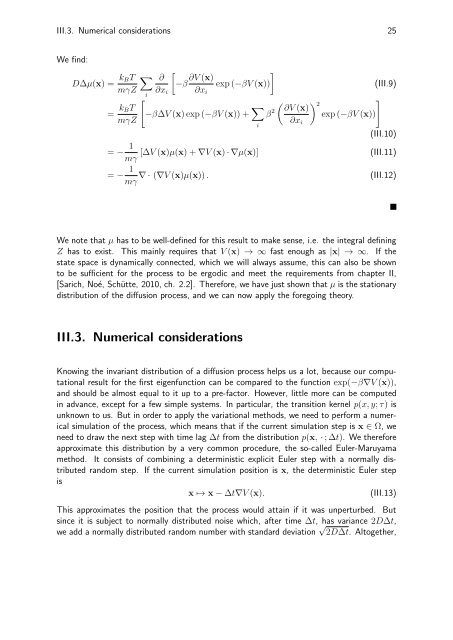Variational Principles in Conformation Dynamics - FU Berlin, FB MI
Variational Principles in Conformation Dynamics - FU Berlin, FB MI
Variational Principles in Conformation Dynamics - FU Berlin, FB MI
- No tags were found...
Create successful ePaper yourself
Turn your PDF publications into a flip-book with our unique Google optimized e-Paper software.
III.3. Numerical considerations 25We f<strong>in</strong>d:D∆µ(x) = k BT mγZi= k BTmγZ∂ ∂V (x)−β exp (−βV (x))∂x i ∂x i−β∆V (x)exp(−βV (x)) + i= − 1 [∆V (x)µ(x)+∇V (x) ·∇µ(x)]mγ (III.11)= − 1 ∇· (∇V (x)µ(x)) .mγ (III.12)(III.9) 2 ∂V (x)β 2 exp (−βV (x))∂x i(III.10)We note that µ has to be well-def<strong>in</strong>ed for this result to make sense, i.e. the <strong>in</strong>tegral def<strong>in</strong><strong>in</strong>gZ has to exist. This ma<strong>in</strong>ly requires that V (x) →∞fast enough as |x| →∞. If thestate space is dynamically connected, which we will always assume, this can also be shownto be sufficient for the process to be ergodic and meet the requirements from chapter II,[Sarich, Noé, Schütte, 2010, ch. 2.2]. Therefore,wehavejustshownthatµ is the stationarydistribution of the diffusion process, and we can now apply the forego<strong>in</strong>g theory.III.3. Numerical considerationsKnow<strong>in</strong>g the <strong>in</strong>variant distribution of a diffusion process helps us a lot, because our computationalresult for the first eigenfunction can be compared to the function exp(−β∇V (x)),and should be almost equal to it up to a pre-factor. However, little more can be computed<strong>in</strong> advance, except for a few simple systems. In particular, the transition kernel p(x, y; τ) isunknown to us. But <strong>in</strong> order to apply the variational methods, we need to perform a numericalsimulation of the process, which means that if the current simulation step is x ∈ Ω, weneed to draw the next step with time lag ∆t from the distribution p(x, · ;∆t). Wethereforeapproximate this distribution by a very common procedure, the so-called Euler-Maruyamamethod. It consists of comb<strong>in</strong><strong>in</strong>g a determ<strong>in</strong>istic explicit Euler step with a normally distributedrandom step. If the current simulation position is x, thedeterm<strong>in</strong>isticEulerstepisx → x − ∆t∇V (x).(III.13)This approximates the position that the process would atta<strong>in</strong> if it was unperturbed. Buts<strong>in</strong>ce it is subject to normally distributed noise which, after time ∆t, hasvariance2D∆t,we add a normally distributed random number with standard deviation √ 2D∆t. Altogether,









